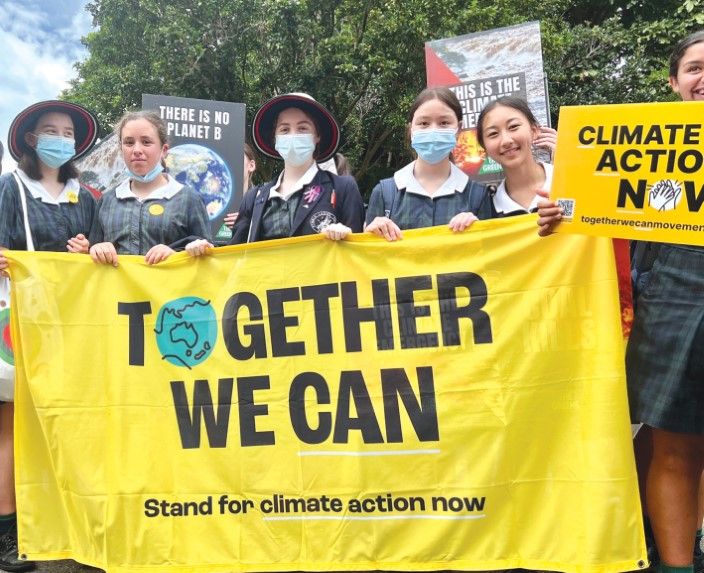Politically conservative commentators describe the development of such critical faculties as “brainwashing”. Schools are “awash in green-left dogma”, bemoaned Tony Thomas in Quadrant. Sustainability as a cross-curriculum priority enables “direct green/left indoctrination”.
Former Prime Minister Scott Morrison wanted “less activism” in schools. NSW Education Minister Sarah Mitchell opposed the strikes in March 2022 by telling students to save their activism for the weekend.
But the climate protest genie is out of the bottle.
Sustainability is entrenched in the Australian curriculum and Verlie says the school strikes denote a critical shift in decades-old youth climate activism, “one that directly enrols education and schools into the arena of climate politics”.
What should schools and teachers do?
It is ‘climate justice’ rather than climate change that motivates students, and what they find lacking in environmental education at school. They want to know how to change things.
AJEE contributor Peta White and her co-authors call for education systems to be reimagined and reformed “to become spaces where young people learn and refine skills for political engagement”.
To be relevant, schools must offer ways to “meaningfully engage student voice” about the climate crisis.
She seeks education where teachers and students work collaboratively to prevent climate injustice from escalating.
Verlie suggests teachers support “young people’s complex and intense emotions” about climate justice by listening to them and helping them find meaningful ways of responding.
AJEE researchers propose four big changes to education:
- Recognise that young people are living through climate change right now and it’s not something to be studied from a dispassionate distance.
- Take young voices seriously; educators must listen to, support and work alongside their students.
- Reconsider the outdated notion that students can be educated to “manage” the planet; instead, embrace collective responsibility.
- Learn to respond to uncertainty and complex challenges.
Practical solutions
Students told AJEE that education for sustainability programs running outside schools, such as New Zealand’s Enviroschools, involve problem-solving and guide students towards practical, project-based learning. They would respond strongly to the inclusion of such programs within schools.
At Cornish College in Melbourne’s east, principal Nicola Forrest has won awards for helping to “embed” sustainability in the school’s core curriculum. Cornish was set up with the mission and “moral purpose” of “education for a sustainable future”. It uses 100 acres of farmland to connect children to nature through hands-on outdoor learning, including tending beehives and working in an EcoCentre that features aquaponics, guinea fowl, geese, ducks, vegetable patches, worm farms, compost heaps and recycling.
Forrest views the official state curriculum through the “lens of sustainability” and defines sustainability at Cornish College as “making a difference for a world where there is enough for all, forever”.
Canadian researchers Gregory Lowan-Trudeau and Teresa Anne Fowler support “experiential, place-based teaching and learning opportunities”, citing in situ renewable energy installations in Alberta where staff and students can see how much energy they are consuming and saving.
However, they warn that most educators are grounded in one speciality and find it challenging to know all the social, political, ecological, and technical aspects of such projects.
Climate striker Catherine told AJEE authors Maria L Bright and Chris Eames that classroom strategies that motivated students would engage “the head, the heart, and the hands”. Strike participant Jake said it was vital students undertook “project-based learning”.
The challenge
Author Peta White and her fellow journal contributors say the “children of climate change are more adept at responding to the uncertain and complex challenges of our times than many of us adults”.
“School strikers understand better than anybody that they cannot do this alone and are simply saying: please listen to us but do not leave it up to us,” the contributors say.
They urge educators to devise “long-term approaches to learning and working alongside young people in non-hierarchical, democratic and multigenerational solidarity”.
They say we need to:
acknowledge that young people are forced into civil disobedience to take political action to generate change about social/climate justicewelcome the fact that young people may come to climate change activism through humanitarian and social justice perspectives as well as through engaged critical science agencyunderstand that young people appreciate a need to comprehend climate science but only as far as it enables them to take necessary action to generate changeappreciate that we are experiencing a global phenomenon that involves young people engaging with government and demanding government action.The AJEE’s deep dive into the school strikes reveals that young people do not merely want to engage with the political system, they want to transform it. And that’s what they want to be taught.















































































































































